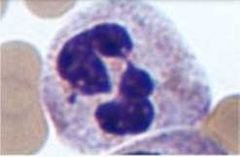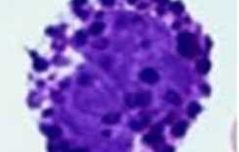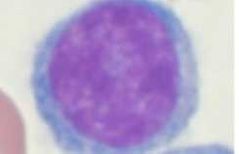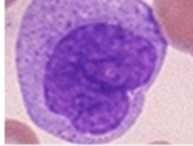![]()
![]()
![]()
Use LEFT and RIGHT arrow keys to navigate between flashcards;
Use UP and DOWN arrow keys to flip the card;
H to show hint;
A reads text to speech;
30 Cards in this Set
- Front
- Back

Name and Purpose |
Neutrophil.
Most common Granulocyte (40-75%). Pink granule appearance, polymorphonuclear (multiple lobes).
Crucial for Innate Defense, first responder to infection, phagocytic and cytotoxic.
Eliminates BACTERIA AND FUNGI. |
|

Name and Purpose |
Eosinophil. Innate defense system granulocyte. Polymorphonuclear, pink/red granules. Purely CYTOTOXIC, eliminates extracellular parasites (protozoans, helminths), aids in ALLERGIC RESPONSE. |
|

Name and Purpose |
Basophil, Innate defense granulocyte. Least common (<1%).
BI-LOBED, dark purple granules. Degranulates in response to allergens, role in immune response. Aids in acute inflammatory response to parasitic infections. |
|

Name and Purpose |
Lymphocyte, role in Innate and Adaptive responses. Round nucleus with minimal cytoplasm, NO GRANULES. NK Cells: Purely Cytotoxic, eliminate intracellular threats (cancer and viruses). B Cells: Secrete antibodies. T Cells: Secrete CYTOKINES (helper CD4+), eliminate intracellular threats (killer CD8+). |
|

Name and Purpose |
Monocyte. Innate defense, kidney-bean nucleus with fine-glass appearance. Granules are so fine that it is considered an AGRANULOCYTE. Enter tissues and differentiate into macrophages/dendritic cells.
Phagocytic, role in bacteria and fungal elimination. |
|

Name and Purpose |
Dendritic Cell. Innate defense. Monocyte-like appearance (kidney-bean nucleus). Phagocytic, ANTIGEN-PRESENTING. Presents processed (degraded) antigens to T Cells to mount adaptive response. SENTINEL CELLS. |
|
|
Identity and Purpose of Tissue Resident Immune Cells |
Mast Cells and Macrophages.
Mast Cells derive from basophils, release histaimine in response to acute inflammatory response and allergic response.
Macrophages are phagocytic, derive from Monocytes, release histamine and cytokines in acute and chronic inflammation. |
|
|
Immune Role of Red Bone Marrow |
PRIMARY Immune Organ. Contains Hematopoietic Stem Cells - self-replicating multipotent cells that differentiate into all immune and blood cells. B and T Cells develop here, B cells MATURE here. |
|
|
Immune Role of Thymus |
Gland, anterior to heart. Dense outer cortex and inner medula, site of T Cell MATURATION. |
|
|
Immune Role of Lymph Nodes |
SECONDARY Immune organs, bean-shaped throughout body. Filter lymph collected from interstitial fluid sources throughout body. Major site of B and T cell ACTIVATION. |
|
|
Immune Role of Spleen |
Has Red pulp and White pulp. Red Pulp - Filter blood, store platelets, store extra blood for shock. White Pulp - Small nodes within spleen, full of mature B and T cells to activate in response to bloodborne antigens. Filters blood, stores RBC, WBC, Platelets. Triggers immune response to antigens in BLOOD, not INTERSTITIAL FLUID. |
|
|
Immune Role of MALTs |
Secondary Immune organs. Mucosa-Associated Lymphoid Tissues. In Lamina Prpria of mucosal membranes in GI, respiratory, urinogenital tracts. Resemble Lymph Nodes - full of B and T cells to respond to antigen presence. |
|
|
What is included under the umbrella of "Leukocytes"? |
White blood cells. Includes Lymphocytes, Monocytes, and all Granulocytes (baso, eosino, neutro). |
|
|
What is circulating blood composed of? |
Plasma (55%) - Water, plasma proteins (albumin and fibrinogen for clotting). Red Blood (45%) - RBCs. Buffy Coat (<1%) - Platelets and all Leukocytes (lymphocytes, monocytes, granulocytes). |
|

What type of cell is this? |
Neutrophils (polymorphonuclear), light pink granules. |
|

What type of cells are these? |
Neutrophils. Lobes DO NOT NEED TO SEPARATE, can appear as one long lumpy, but continuous, nucleus. |
|

What type of cell is this? |
Lymphocytes |
|

What type of cell is this? |
MONOCYTES |
|

What type of cell is this? |
Eosinophil. Dark red granules, polymorphonuclear. |
|

What type of cell is this? |
Basophils. Dark blue/purple staining (BASOPHILIC). |
|
|
How can we tell apart B and T-Cell Lymphocytes? |
Morphologically IDENTICAL. Requires immunophenotypic analysis involving antibody-specific targeting of B or T-cell surface/cytoplasmic/nuclear antigens. |
|
|
Severe Congenital Neutropenia |
Genetic disorder affecting hematopoiesis of granulocytes, leading to Neutropenia (neutrophil deficiency). Found in early infants with life-threatening bacterial infections (commonly Staphylococcus). |
|
|
Chediak-Higashi Syndrome |

Deficiency in lysosome/vesicle formation leads to grossly impaired phagocytic function. Manifests as recurrent infections by bacteria and fungi, results in albinism (pale skin, grey irises) and neutrophils with excessive nuclei. |
|
|
What do Monocytes produce? |
Monocytes enter tissues and differentiate into Macrophages and Dendritic Cells. |
|
|
Purpose of Macrophages - M1 and M2 |
Differentiate from monocytes once they enter cells, so they are tissue resident. Form of 'sentinel' cell that first encounters antigens in Secondary Lymph Organs (nodes and spleen). Do not circulate. M1 macrophages secrete inflammatory cytokines, M2 macrophages secrete anti-inflammatory cytokines to heal after an immune response. |
|
|
What are the phagocytic killing mechanisms? What cells utilize them? |
All innate phagocytic leukocytes (Neutrophils, Monocytes, Macrophages, Dendritic Cells) phagocytize invaders. They can be attracted by opsonins that have been formed on pathogen membrane surfaces. Killing is Oxygen-dependent or Oxygen-independent. |
|
|
O2-Independent vs O2-Dependent Killing |
2 methods used by phagosomes (Neutrophils, Macrophage, Monocytes, Dendritic Cells). O2-Independent is usual lysosomal degradation of pathogens within phagocytes. O2-Dependent is for more aggressive pathogens, requires generation of reactive O2 and Nitrogen species to directly damage pathogen nucleic acids and proteins. |
|
|
Purpose of Glutathione and Catalase |
Antioxidants, clean up after O2-dependent killing occurs. Bacteria that express their own Catalase are an issue for neutrophil-deficient patients. |
|
|
Myeloperoxidase (MPO) Deficiency |
Myeloperoxidase is an agent of the body which aids in oxygen-dependent killing of aggressive pathogens by creating hypochlorous acid. A Neutrophil deficiency that impairs MPO function DO NOT exhibit overt immune deficiency, but are repeatedly reinfected by CANDIDA ALBICANS -> causing Candidiasis. |
|
|
Chronic Granulomatous Disease (CGD) |
NADPH Oxidase aids in generation of Oxygen Radicals for O2-dependent killing by phagocytes. CGD is a neutrophil defect impairing the oxidase, impairing its function. Resulting impaired killing of Fungi and Catalase(antioxidant)-expressing bacteria leads to GRANULOMA formation, or masses of granulation tissue. Patient exhibits recurrent bacterial/fungi infections, but NORMAL IMMUNITY TO VIRUSES. |

